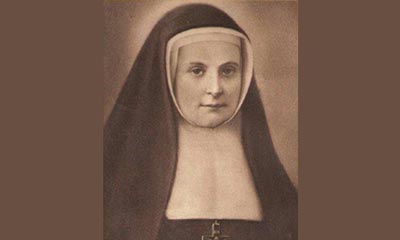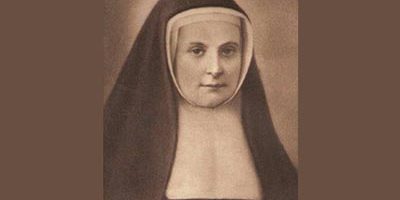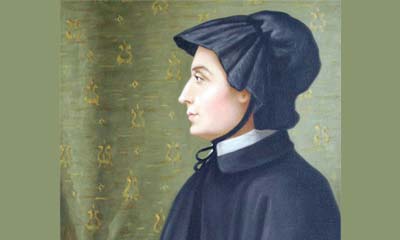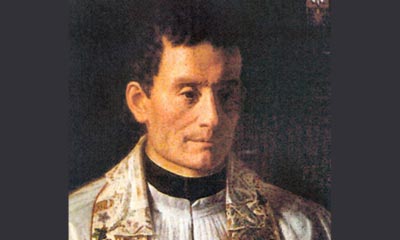October 15, 2021
Blessed Marie-Thérèse Soubiran
Dear Friends,
“Lest we consider things under the sole supernatural light of faith,” Pope Pius XII told the Sisters of Mary Help of Christians, “the human mind will always remain bewildered by the account of your Blessed Mother’s mortal life; by the contrast between the grandiose and shining work to which God had destined her and the series of tribulations through which He led her… The vision of her spirit and the impetus of her heart seem to express themselves entirely in this exclamation from a psalm which was particularly dear to her: He has set my feet on a spacious path to Heaven, because He truly loved me (cf. Ps 17:20; 30:9). Can the way of Marie-Thérèse de Soubiran be called a spacious path opened by love? Was there ever a narrower, steeper, rougher, more obscure path? Was there ever a more incoherent path, as our poor, limited human wisdom would say? And it remained that way throughout her life!” (October 22, 1946).
 Sophie-Thérèse was born on May 16, 1834, in Castelnaudary, to the Baron Joseph de Soubiran and Noémi Gélis. Following the decease of four brothers and sisters at an early age, she was herself stricken with typhoid fever when aged only three. A friend suggested that she should receive the scapular of Mount Carmel. It was under the habit of the Blessed Virgin that she was healed. By way of thanksgiving, she was enrolled in the congregation of the Children of Mary, directed by her uncle, Canon de Soubiran. Soon, a little sister, Marie, came to brighten Sophie-Thérèse’s childhood. At her First Holy Communion on June 29, 1845, Sophie-Thérèse asked Jesus for the grace of a religious vocation. At age twelve, during a retreat, she clearly perceived the love of God in her heart, and two years later, she obtained permission to make a temporary vow of virginity. She also learned, not without difficulty, to renounce her own will. She had a burning desire to enter the Carmel, but the Lord gave her the inner understanding that this grace would not be given her.
Sophie-Thérèse was born on May 16, 1834, in Castelnaudary, to the Baron Joseph de Soubiran and Noémi Gélis. Following the decease of four brothers and sisters at an early age, she was herself stricken with typhoid fever when aged only three. A friend suggested that she should receive the scapular of Mount Carmel. It was under the habit of the Blessed Virgin that she was healed. By way of thanksgiving, she was enrolled in the congregation of the Children of Mary, directed by her uncle, Canon de Soubiran. Soon, a little sister, Marie, came to brighten Sophie-Thérèse’s childhood. At her First Holy Communion on June 29, 1845, Sophie-Thérèse asked Jesus for the grace of a religious vocation. At age twelve, during a retreat, she clearly perceived the love of God in her heart, and two years later, she obtained permission to make a temporary vow of virginity. She also learned, not without difficulty, to renounce her own will. She had a burning desire to enter the Carmel, but the Lord gave her the inner understanding that this grace would not be given her.
A very shy niece
A core group of young girls in the congregation of the Children of Mary wanted to lead a more secluded life, devoting themselves to prayer. This gave Canon de Soubiran the idea of setting up a “Beguinage” in Castelnaudary: a group of women who, without taking vows, live together under a suitable rule. Sophie-Thérèse was well aware of the illusory nature of such a project, but her uncle advised his “very timid niece,” as he sometimes called her, to consider the proposition and to seek counsel elsewhere. She turned to Father Roucanière, a Jesuit, who encouraged her to view the plan as a call from Providence. Sophie-Thérèse was deeply distressed, and a real sense of dread assailed her. However, an encounter with Bishop Delbecque, bishop of Ghent (Belgium), himself superior of a Beguinage, gave her peace of mind. She wrote: “The details of the sorrows to come were so clearly shown to me that I was frozen with fear. And, indeed, twenty years later, everything happened as foreseen with the most faithful accuracy. It is to be noted that God almost always deigns, before acting, to solicit and obtain the consent of the soul, treating with loving respect the freedom of the work of his hands. A great peace followed this resolution. Never since then did I have the slightest of doubts.”
In August 1854, Sophie-Thérèse, together with another young girl, stayed at the Beguinage in Ghent. In September, the two companions returned to France to establish a Beguinage in Castelnaudary. The beginnings were difficult because of malicious gossip in the neighborhood. But before long, Sophie-Thérèse observed that several of her companions wanted to lead a more formal religious life, and she steered them in that direction. Hence, two forms of life coexisted in the small enclosure: there were the small individual houses of the Beguinage, but also, grouped around the one who had become Mother Thérèse, young girls who wanted to lead a stricter religious life now gathered. On January 5, 1855, Mother Thérèse pronounced her perpetual vow of virginity.
The Sisters’ subsistence was provided by their daily work, and for them poverty was not an empty word. The buildings which were needed to accommodate postulants and the homeless children who were pouring in, were built with the active participation of the community: they hauled in construction materials and dug the foundations. But during the night of November 5-6, 1861, a fire destroyed the building that had taken so much effort to erect. The orphans housed on the first floor managed to climb onto the roof together with the sister who was looking after them. But the city was not equipped to fight the fire, and the ladders proved too short! A tall and vigorous former convict clamped himself to the wall, supporting the largest ladder on his chest. Mother Thérèse threw a scapular of Mount Carmel into the fire: the flames parted sufficiently to allow the rescue to take place. One victim was killed during the disaster, however. After the tragedy, Mother Thérèse spent the rest of the night in prayer with her daughters.
The institute soon became a congregation focused on Eucharistic adoration, under the patronage of Mary Help of Christians. On September 8, 1862, the new religious family was consecrated to Our Lady as its Mother and Superior; the nuns would all bear her blessed name. The community’s life of poverty became more intense. All the Sisters worked with great zeal, and public charity came pouring in: the misfortunes they had endured with such courage had overcome the prejudice of the population.
Lightning flashes of love
At this point, Mother Marie-Thérèse entered a period of four years of violent temptations against her faith; anger and darkness were her daily fare. Now and then, a lightning flash of love confirmed her in her vocation, but immediately afterwards, temptation would return. In this world, the Catechism of the Catholic Church teaches, “‘we walk by faith, not by sight’ (2 Cor 5:7); we perceive God as ‘in a mirror, dimly’ and only ‘in part’ (1 Cor 13:12). Even though enlightened by him in whom it believes, faith is often lived in darkness and can be put to the test. The world we live in often seems very far from the one promised us by faith. Our experiences of evil and suffering, injustice and death, seem to contradict the Good News; they can shake our faith and become a temptation against it.” Faced with this spiritual trial, Mother Marie-Thérèse patiently persevered on her path of darkness, pursuing the design she had embraced under the light of God.
In 1863, on the anniversary of the fire, she organized a vigil of adoration of the Blessed Sacrament. Soon, at the request of the Sisters, nocturnal adoration took place each day. At the end of a thirty-day Ignatian retreat, Mother clearly understood that God truly desired “Mary Help of Christians,” and that this included, for her, “the obligation to remain there, to work for its establishment and extension.” The new Society was orientated towards the expiation of sins, the imitation of Christ, humble and lovingly faithful obedience, constantly striving for poverty and chastity, under the gaze of Mary Help of Christians. Mother Marie-Thérèse was aware of the rural exodus of young people to the city where industrialization was beginning to develop. The apostolic project of the Congregation of Mary Help of Christians was therefore to “support young girls from the age of fourteen to about twenty-five. Especially that part of the youth who live in the big cities without a family, and who work in workshops and factories. This goal is a necessity in our modern societies which centralize everything and replace Christian families by masses of individuals.” After appointing a superior to run the Beguinage in Castelnaudary, Mother emigrated, with those who were prepared to join her, to Toulouse. On November 20, their chapel was blessed and adoration of the Blessed Sacrament was established the very next day.
“Your mission is over”
Immersed in the spirituality of the Exercises of St. Ignatius and the spirit of the Carmel, Mother Marie-Thérèse included these words in the Rules of Mary Help of Christians: “It is the spirit of simplicity and of holy lowliness that must be our proper spirit; it will always prevent us from disdaining as too common and too vulgar any of the works that it may please Providence to entrust to us…” She desired for the daughters of Mary Help of Christians always to first choose the last place, to have a predilection for the neglected, and to show an infinite flexibility in creating, abandoning, persevering, and renouncing. Pius IX officially approved the Society on December 19, 1868. Foundations in Amiens, Lyons and London were established in a spirit of peace, despite great tribulations and hardships. Mother Marie-Thérèse’s soul was in a state of heavy darkness, but this painful situation did not prevent her from radiating confidence and stability of vision: “It is,” she admitted, “the subject of a great miracle of the goodness of Our Lord for the Society: the miracle of preserving everything in spite of myself.”
The London foundation was established during the Franco-Prussian war of 1870: in 1871, the Sisters who had been forced to flee returned to France. During their stay in Great Britain, one of them, Mother Marie-François de Borgia, had begun to gain prominence. This sister, who had joined the very young community as a mature woman in 1868, had managed to dissimulate the fact that she was married. For several years, her extraordinary adaptability had allowed her to conceal her extreme self-confidence and her inordinate love of the limelight. She was incapable of understanding the meaning of the spirit of submission, and had come to see the Mother superior’s unspectacular heroism and humility as shortcomings that made her unfit for leadership. Fascinated by the strong personality of Mother Marie-François, the Sisters elected her as Assistant General to their Foundress. Mother Marie-Thérèse’s habitually self-effacing attitude and her mistrust of her own views led her to rely more and more on her assistant. She would later blame herself for not having confided sufficiently in the Almighty Power of God, and for having entrusted herself too much to a creature. In an inner locution, the Lord warned her: “Your mission is over; soon, the Society will not even have a place for you; but I will lead all things with equal strength and gentleness.”
Mother Marie-François, who had conceived the project of taking in war orphans and teaching them a trade, succeeded in being appointed general bursar. Under her impetus, in 1873, all the houses were equipped with workshops for up to 150 children. Mother Marie-Thérèse presented the difficulties she was encountering to her assistant. The latter then skillfully began to instill doubts about the foundress in the community. In a report on Society’s financial situation, she stated that it was burdened with a substantial debt. In reality, many of the “debts” listed were in fact only quotes received; moreover, it would have sufficed to suspend some construction works and to close some of the workshops in order to redress the financial situation. Instead, Mother Marie-François took advantage of a council meeting to accuse the Foundress of “pride, ambition and terrible irregularities which can only bring God’s curse upon the Society,” and of “not knowing how to govern or administer.” The threat of bankruptcy brandished by the assistant had a decisive effect on the Sisters: the Foundress must be dismissed! Bishop de la Tour d’Auvergne, the ecclesiastical superior of the Society, also believed that bankruptcy was imminent. The Foundress resigned. Mother Marie-François was named Superior General on February 13, 1874. She immediately decided to remove Mother Marie-Thérèse, who went to the Sisters of Saint Vincent de Paul in Clermont-Ferrand.
The weight of souls
“In order to save this dear little Society,” the Foundress would later write, “I made the oh so difficult sacrifice of not seeing it again. Only God knows how dear it was to me… My most acute pain was the sight of so many souls who, in a way, belonged to me, and whose vows, I was told, were going to be broken by my fault alone [if she did not resign]. Oh! the weight of souls is a pain like no other, and one that only such as has suffered it can understand… Together with this sea of bitterness, there came another very palpable sorrow: separation from my sister [Mother Marie-Xavier, who had joined her as a religious]… Finally, a third thorn was my much-loved vocation that I was close to losing forever; my vows were on the verge of breaking, with little hope of ever recovering them… Abandoned by all those I loved, by those in whom I had placed all my trust, I was cast away without a refuge… obliged to keep silent and thus let everything weigh on me alone.” In her deep distress, Mother Marie-Thérèse lifted up her soul: “I would not have wanted to change places… It seemed to me that, through this suffering, I was working more than by any other means for the good of the Society, and for the alleviation of the anguish and difficulties that oppress it.”
Mother Marie-François led the Sisters of the council to believe that their Mother Foundress had left the Institute of her own accord. On March 26, 1874, Mother Thérèse wrote to her: “I am at the disposal of Our Lord, that is, in your hands… I hope that holy obedience will have the last word and that I will be at peace no matter what it decides… I had to write to the Bishop of Bourges (Bishop de la Tour d’Auvergne) as I had already done to yourself that, if I were no longer to return to the Society, I would beg His Grandeur to relieve me of my vows, and to be good enough to have my signature cleared from all the affairs of the Society…” Mother Marie-François tried to induce her to accept the superiorate of the house in London with the intention of then separating this foundation from the Institute. But the bishop sensed that this was a maneuver, and warned the Foundress. “Our good Mothers only wanted me to return,” she later wrote, “if London was to become a separate institution from Marie Help of Christians. This was not acceptable.” In her ordeal, she sought to anchor herself in prayer: “Only my God was there for me. He alone was good and tender… and He deigned to pour into my soul treasures of faith, hope and love which I would never have tasted, I know, had I not lived through this torrent of pain… Inasmuch as it depended on me, I made myself poor with Jesus Christ in His poverty… and my soul overflowed with the joy of having only His God.”
A tiny postulant
After several failed attempts to enter a religious order, Mother Marie-Thérèse was received on September 20 at Notre-Dame de Charité du Refuge in Paris, where she was given the name Sister Mary of the Sacred Heart. She wrote to Mother Marie-François: “I have become a tiny postulant. May the One who so lovingly made Himself small and poor give me enough courage to want to be also, after His example, small and truly poor of myself.” She subjected herself with simplicity to all the little habits proper to a community that she did not yet know: “I will show myself to be gentle, humble, grateful for the work of death that God is willing to work in me through the creatures that hurt me,” she noted… “In this world I am a stranger, I am destined to leave.” Some nuns later testified that “when she spoke of God her face was inflamed, her eyes lit up, an intense life seemed to seize her; this was in stark contrast to her customary sickly outward appearance.”
In the Society that she had founded, the novices no longer even heard of her. But the government of Mother Marie-François took a despotic turn, imposing unceasing activities that were an obstacle to recollection and the inner life; she also, without the advice of the council, expelled some thirty Sisters. The spirituality of St. Ignatius was abandoned in favor of that of St. Francis and then of St. Dominic; ultimately, the spirit of none of them was alive in the Society. New houses were founded and closed at a high rate: in fifteen years, the Society experienced eleven transfers of its novitiate and seven successive mistresses of the novices were appointed. Well aware of the evil afoot, the ecclesiastical authorities dared not to take decisive action, out of fear of dealing a fatal blow to the Society. However, the sufferings of the nuns were unknown beyond the walls of its houses, and the purest religious spirit was maintained thanks to these silent immolations, which were borne of the ignored Foundress’ own sacrifice. Mother Marie-Xavier obtained permission to visit her every year, but was absolutely forbidden to speak about the Society. But on January 3, 1881, Mother Marie-Xavier, who had been suddenly expelled, herself came to ask to be admitted to Notre-Dame de la Charité. It was a hard blow for the Foundress.
On October 7, 1888, Mother Marie-Thérèse entered the infirmary where she died on the eve of Pentecost, June 7, 1889, with these words on her lips: “Come, Lord Jesus, come!” Her intimate writings end with these words: “I must affirm as very certain truths: that no one really wanted to cause me pain… that everything happened, however, because the Good God willed it or allowed it in His designs of mercy and love for my soul; that in spite of my pride, by a particular grace, I have with reason never doubted that from every point of view it was very advantageous for Mary Help of Christians to get rid of me. It was only my nature that found the means violent, especially when I would have given myself over at any rate, so it seems to me; but, once again, these means were necessary for my soul and they procured for me very great spiritual goods.”
Veneration made possible at last
The government of Mother Marie-François collapsed after the death of Marie-Thérèse de Soubiran; on February 13, 1890, the usurper abruptly announced her resignation and left the Institute. Two Sisters of the council put her papers in order and unearthed the correspondence she had had with their Foundress. The truth came to light. The foundress was vindicated within the community and the older sisters were able openly to pass on to the younger ones their veneration for their true Mother. On October 20, 1946, Mother Marie-Thérèse de Soubiran was proclaimed Blessed by Pius XII. In 2017, her congregation numbered one hundred and sixty Sisters in twenty-three houses in Europe, Africa, Asia and Oceania.
The story of Mother Marie-Thérèse is disconcerting. She was a Foundress, but she was also unjustly accused and then obliged to leave her institute, penniless, in order to spend her remaining life in another religious congregation, while a schemer took her place and put her institute in danger. Only a gaze of faith towards Providence can begin to explain this. God sovereignly governs the world and, while respecting the freedom He has bestowed on His intelligent creatures, His Almighty power ensures “that to them that love God, all things work together unto good” (Rom 8:28). “God made the world and He disrupts it only to make saints,” Mother de Soubiran once said. It was by means of her heavy trials, having been so painfully stripped of all things, that she regained the purity of her childhood. At the end of her life, she could write: “The Good Lord is taking me back to the soul that was mine at fifteen, I mean to the simple and tender love I had at that age. Like a child of love, I live in peace on the bosom of my God and there I delight in my possession. I have for Him the confidence of a child in the arms of the most tender of mothers. In Him and through Him, I doubt nothing. I expect everything from Him, for myself and for those I love, for time and for eternity” (Spiritual Writings, p. 63).
The Truth taught Mother Marie-Thérèse two things, as Pope Pius XII explained: “The first is the secret of total detachment: it freed her all distrust of the heart, from pride of spirit, and showed her the emptiness and instability of created things… The second, which she received from the very lips of the Divine Master, is this: Unless the grain of wheat falling into the ground die, itself remains alone. But if it die, it brings forth much fruit (Jn 12:24-25)… We are given the opportunity today to admire the powerful effectiveness of these two truths. Through so many upheavals, what a marvel of holiness did God achieve in her! From her abasement, from her entombment in the deepest abyss of humiliation, what an admirable harvest has sprung up! And what a wide and spacious way love has opened before her feet!”
May Blessed Marie-Thérèse de Soubiran obtain for us the grace to follow her example of humility!









